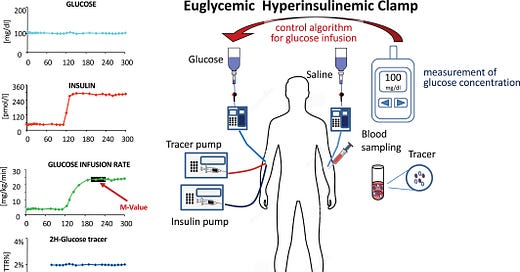From Static to Functional Measurements: Towards a Truer Approximation of Health
From Genomics to Functional Genomics. From Blood Glucose to Insulin Sensitivity. Function is Health
Many would agree that defining health as “the absence of disease” is insufficient.
The World Health Organization defines health as “a state of complete physical, mental and social well-being and not merely the absence of disease or infirmity.”
Now to define “well-being.” The Oxford dictionary states this as “the state of being comfortable, healthy, or happy.”
Now, we are in a pickle. Well-being is being healthy, and being healthy is being well. SO… what is health??
My definition of health: the capacity of an individual to adapt, respond, and function optimally in any environment or challenge encountered throughout their lifespan.
The key word is function. The good news is, while well-being and health are very hard to define, we can very often define, and even quantify, functions. In this article I argue that in order to move towards a healthier society, we need to begin measuring health with metrics that actually represent an achievable goal. The healthcare system, and even many R&D efforts in the biomedical and healthcare industry, still relies heavily on static (opposite of functional) measures of disease. To transition from the “absence of disease” model, we need to design interventions that improve measures of health.
I will discuss two examples:
RNA expression analysis can tell you more about health than DNA sequencing; implications for consumer biotech
Insulin sensitivity is an integrated measure of health: implications for metabolic health
RNA Expression vs. DNA Sequencing
DNA serves as the static blueprint of life, but RNA transcription—and by extension, protein translation—responds dynamically to environmental changes. While DNA mutations accumulate over a lifetime in response to environmental stressors and toxins, RNA expression operates on a vastly shorter timescale, capturing real-time physiological responses. Moreover, RNA sequencing can target specific cells, tissues, or interventions, offering unparalleled flexibility and precision in measurement.
For instance, to assess the impact of diet on inflammation, RNA expression can be analyzed in peripheral immune cells, focusing on genes such as TNFα, IL6, and IL1B, which encode key inflammatory cytokines. Among these, IL6—a driver of nearly every inflammatory process—is a critical biomarker of chronic inflammation. Acute inflammation, in controlled bursts, promotes beneficial adaptation. However, persistently elevated IL6 mRNA levels in circulating immune cells could serve as a reliable indicator of chronic inflammatory status.
Why is mRNA a superior biomarker compared to DNA?
One of the key distinctions lies in their temporal dynamics. The median half-life of mRNA is approximately 7 hours, making it exquisitely sensitive to short-term physiological changes. In contrast, DNA is far more stable, with an estimated half-life of 520 years (at least in fossilized bone). When measuring responses to lifestyle interventions, dietary changes, or treatment regimens, mRNA provides a faster and more informative window into the body’s adaptive processes.
If mRNA is such a promising biomarker, why isn’t it widely used in labs or preventive medicine clinics? The answer likely lies in the economics of diagnostics. While the FDA has approved RNA biomarkers for specific applications, such as prostate cancer detection, RNA-based diagnostics for general health do not align well with existing healthcare paradigms. Health insurance models, which prioritize disease treatment over prevention, are unlikely to cover tests designed for health optimization. After all, insurers have little incentive to invest in diagnostics that primarily aim to prevent risk rather than mitigate disease.
Who will champion consumer RNA diagnostics?
In the absence of insurance reimbursement, the responsibility shifts to direct-to-consumer companies. Pioneers like Function Health, offering blood-based biomarkers, or Viome, which sequences RNA from the gut microbiome to deliver personalized nutrition insights, are already exploring this space. These companies offer consumers a sense of health assurance and tailored recommendations, albeit at a personal cost.
However, the commercial limitations of DNA sequencing highlight a critical opportunity for RNA-based diagnostics. Companies like 23andMe have demonstrated that while DNA can provide valuable information, its insights are largely static and limited by the “one-time purchase” business model. In contrast, RNA’s dynamic nature makes it ideally suited for recurring testing, enabling a subscription-based approach to longitudinal health monitoring. This could unlock a scalable, sustainable business model while simultaneously delivering actionable health insights.
The Vision for Consumer RNA Sequencing
The potential for RNA sequencing lies in its ability to generate both meaningful biological insights and a viable commercial model. A comprehensive, responsive RNA profile—regularly tested and correlated with health variables—could transform personalized medicine. With the right infrastructure, a commercially minded biochemist or entrepreneur could build the world’s largest consumer RNA sequencing platform, revolutionizing how we understand and manage health. If you’re working on this vision, I’d love to connect.
In summary, mRNA sequencing bridges the gap between biological responsiveness and the consumer diagnostic business model. Its capacity to capture rapid physiological changes makes it an ideal biomarker for health, while its potential for recurring testing aligns with modern commercial strategies. The convergence of these factors could unlock transformative advances in preventive medicine and personalized health.
Insulin Sensitivity: Gold Standard Measure of Metabolic Health
Metabolism forms the cornerstone of human physiology, orchestrating energy production, cellular repair, and the delicate balance necessary to maintain homeostasis. As such, metabolic health underpins nearly every facet of our overall health. To gain a true understanding of metabolic health, we should anchor our analysis to its gold standard: insulin sensitivity.
The Gold Standard: Insulin Sensitivity
To understand insulin sensitivity, it’s helpful to grasp the concept of the euglycemic hyperinsulinemic clamp—a functional assessment that evaluates how effectively your tissues (muscle, adipose, and liver) respond to insulin in driving glucose into cells. Unlike static measures, such as fasting glucose, this test dynamically isolates variables to provide an integrated picture of metabolic health.
The procedure works as follows: Insulin is infused into the bloodstream at a high, steady concentration to create a hyperinsulinemic state, while glucose is simultaneously infused to maintain euglycemia—a normal blood sugar level. The concentration of glucose in the blood is “clamped” at a constant value, and the rate of glucose infusion required to maintain this equilibrium reflects the sensitivity of the body’s tissues to insulin. Put simply, the more sensitive your tissues are to insulin, the greater the amount of glucose that can be driven into the cells, requiring a higher glucose infusion rate.
The Limitations of Static Measures
While fasting glucose levels are often used as a marker of metabolic health, they fall short of providing the full picture. Blood glucose is highly variable, influenced by factors such as diet, stress, and time of day, and while a high fasting glucose level may signal diabetes risk, it tells us little about the body’s functional ability to manage glucose. Insulin sensitivity, by contrast, represents an integrated, systemic measure of metabolic function—a true reflection of health.
Why Functional Metrics Matter
The euglycemic hyperinsulinemic clamp exemplifies why functional assessments are superior to static metrics. Rather than offering a snapshot, it reveals the physiological capacity of tissues to perform their essential role in glucose metabolism. This dynamic, whole-body perspective underscores the critical importance of metabolic health and offers actionable insights for improving it.
In summary, insulin sensitivity is not only a robust measure of metabolic health but also a key target for interventions aimed at enhancing overall well-being. By focusing on improving this metric, we move closer to a comprehensive understanding of health—grounded in the functionality of our biological systems.
The inverse of insulin sensitivity, e.g. the “disease” metric equivalent, is insulin resistance. Now it would be cool if there were more often analogous metrics of both health AND disease.
Opportunities for THE Human Health Dataset
While I don’t imagine clamps being done all other the world, I would love to see a clinic that amasses one of the largest gold-standard health metric databases in the world. Clamps, VO2max tests, etc. that actually add real functional metrics to the static blood measures that exist today. Just as the Apple Watch has a VO2max metric (that correlates relatively well to the real thing), I could imagine Levels having a metric of insulin sensitivity. What is lacking is the gold standard dataset for health— if you are building this, I would love to talk with you.
Function is Health
While many solutions to mitigate disease, and potentially improve health, often have to fit into the rigid frameworks of FDA-anchored clinical trials, there are opportunities to anchor our lifestyle interventions to measures of health, rather than absence of disease. It requires a reshaping of how we define health, measure it, and make recommendations to improve it. I believe that health should be defined on the ability to function in response to any challenge experienced throughout life (e.g. adaptability), rather than simply the absence of impairments. We can strive to improve our functional capacity if we can define metrics that are independent predictors of longevity, or that are responsive to health interventions.
Core Takeaways
Rather than aligning interventions to prevent values outside of the Gaussian curve of “average,” functional measures to which people can improve are ways of aligning interventions with health
Functional measures provide actionable, context-driven insights that static metrics cannot.
Perturbation as a critical tool: Observing how systems respond to challenges reveals underlying health.
If you are working on a solution to build a healthier world, I would love to hear from you.








Take a look at proteomic company alden scientific.